Foreword / YouTube Video Review
These speakers were provided in kit form by Madisound Speaker Store. I received the standard kit + CNC wood pieces kit + MiniDSP 2x4HD. I purchased the other necessary items (PVC pipe, miscellaneous hardware, etc) and I assembled the speakers myself per the LXmini plans provided upon purchase. The MiniDSP was pre-loaded by Madisound to include the filters for this speaker. Big thank you to Madisound for helping out here.
The review on this website is a brief overview and summary of the objective performance of this speaker. It is not intended to be a deep dive. Moreso, this is information for those who prefer “just the facts” and prefer to have the data without the filler. The video below has more discussion.
Information and Photos
Per Madisound. The LXmini is a creation by world renowned loudspeaker designer Siegfried Linkwitz. Please visit the Linkwitz Lab website for detailed information on this system. Also see the full scale LX521 and LXstudio kits.
Madisound is proud to offer enthusiasts the drivers from Seas of Norway, DSP module from MiniDSP, and Acousta-Stuff damping material at a discounted price. Price shown is discounted and lower than putting together all the parts separately.
Below is a quote from the LXmini designer, Sigfried Linkwitz:
“The LXmini is a most remarkable loudspeaker. It converts electrical signal voltages into acoustic pressure variations, which are perceived as completely neutral and detailed even in a reverberant environment. With this design I want to give every music lover the opportunity to build and enjoy a reference quality sound system singing in their own living space.”- SL
Retail price for the entire setup provided to me is $750 from Madisound. This includes drivers (with a 10% discount), CNC wood parts, some parts and the MiniDSP. I spent about $150 on other miscellaneous items necessary for this project (PVC pipe, nuts/bolts, etc). All in, this project should easily cost under $1000/pair including the necessary DSP. However, a separate amplifier (4-channels of amplification) will also need to be sourced.
CTA-2034 (SPINORAMA) and Accompanying Data
All data collected using Klippel’s Near-Field Scanner. The Near-Field-Scanner 3D (NFS) offers a fully automated acoustic measurement of direct sound radiated from the source under test. The radiated sound is determined in any desired distance and angle in the 3D space outside the scanning surface. Directivity, sound power, SPL response and many more key figures are obtained for any kind of loudspeaker and audio system in near field applications (e.g. studio monitors, mobile devices) as well as far field applications (e.g. professional audio systems). Utilizing a minimum of measurement points, a comprehensive data set is generated containing the loudspeaker’s high resolution, free field sound radiation in the near and far field. For a detailed explanation of how the NFS works and the science behind it, please watch the below discussion with designer Christian Bellmann:
The reference plane in this test is at the 4-inch fullrange driver.
Note: The data below shows calculated SPL at 0.30v input. However, testing was conducted at 0.10v input to the MiniDSP. The KLIPPEL software scales the SPL to the “reference voltage” which in this case is set to 0.30v in my template. Therefore, at 0.10v, the real test SPL was about 85dB @ 1m.
Measurements are provided in a format in accordance with the Standard Method of Measurement for In-Home Loudspeakers (ANSI/CTA-2034-A R-2020). For more information, please see this link.
CTA-2034 / SPINORAMA:
The On-axis Frequency Response (0°) is the universal starting point and in many situations it is a fair representation of the first sound to arrive at a listener’s ears.
The Listening Window is a spatial average of the nine amplitude responses in the ±10º vertical and ±30º horizontal angular range. This encompasses those listeners who sit within a typical home theater audience, as well as those who disregard the normal rules when listening alone.
The Early Reflections curve is an estimate of all single-bounce, first-reflections, in a typical listening room.
Sound Power represents all of the sounds arriving at the listening position after any number of reflections from any direction. It is the weighted rms average of all 70 measurements, with individual measurements weighted according to the portion of the spherical surface that they represent.
Sound Power Directivity Index (SPDI): In this standard the SPDI is defined as the difference between the listening window curve and the sound power curve.
Early Reflections Directivity Index (EPDI): is defined as the difference between the listening window curve and the early reflections curve. In small rooms, early reflections figure prominently in what is measured and heard in the room so this curve may provide insights into potential sound quality.
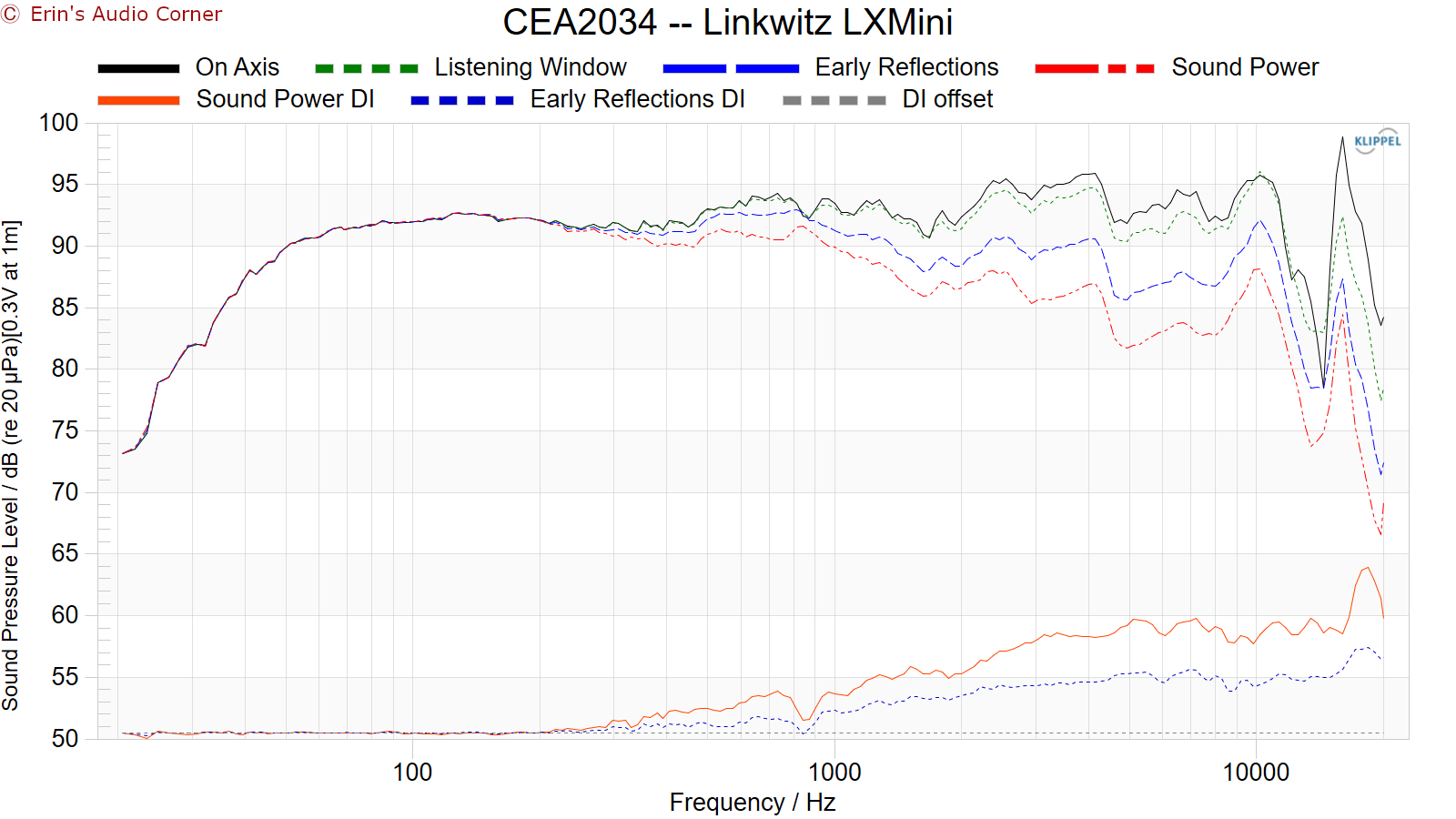
Early Reflections Breakout:
Floor bounce: average of 20º, 30º, 40º down
Ceiling bounce: average of 40º, 50º, 60º up
Front wall bounce: average of 0º, ± 10º, ± 20º, ± 30º horizontal
Side wall bounces: average of ± 40º, ± 50º, ± 60º, ± 70º, ± 80º horizontal
Rear wall bounces: average of 180º, ± 90º horizontal

Estimated In-Room Response:
In theory, with complete 360-degree anechoic data on a loudspeaker and sufficient acoustical and geometrical data on the listening room and its layout it would be possible to estimate with good precision what would be measured by an omnidirectional microphone located in the listening area of that room. By making some simplifying assumptions about the listening space, the data set described above permits a usefully accurate preview of how a given loudspeaker might perform in a typical domestic listening room. Obviously, there are no guarantees, because individual rooms can be acoustically aberrant. Sometimes rooms are excessively reflective (“live”) as happens in certain hot, humid climates, with certain styles of interior décor and in under-furnished rooms. Sometimes rooms are excessively “dead” as in other styles of décor and in some custom home theaters where acoustical treatment has been used excessively. This form of post processing is offered only as an estimate of what might happen in a domestic living space with carpet on the floor and a “normal” amount of seating, drapes and cabinetry.
For these limited circumstances it has been found that a usefully accurate Predicted In-Room (PIR) amplitude response, also known as a “room curve” is obtained by a weighted average consisting of 12 % listening window, 44 % early reflections and 44 % sound power. At very high frequencies errors can creep in because of excessive absorption, microphone directivity, and room geometry. These discrepancies are not considered to be of great importance.

Horizontal Frequency Response (0° to ±90°):

Vertical Frequency Response (0° to ±40°):

Horizontal Contour Plot (normalized):
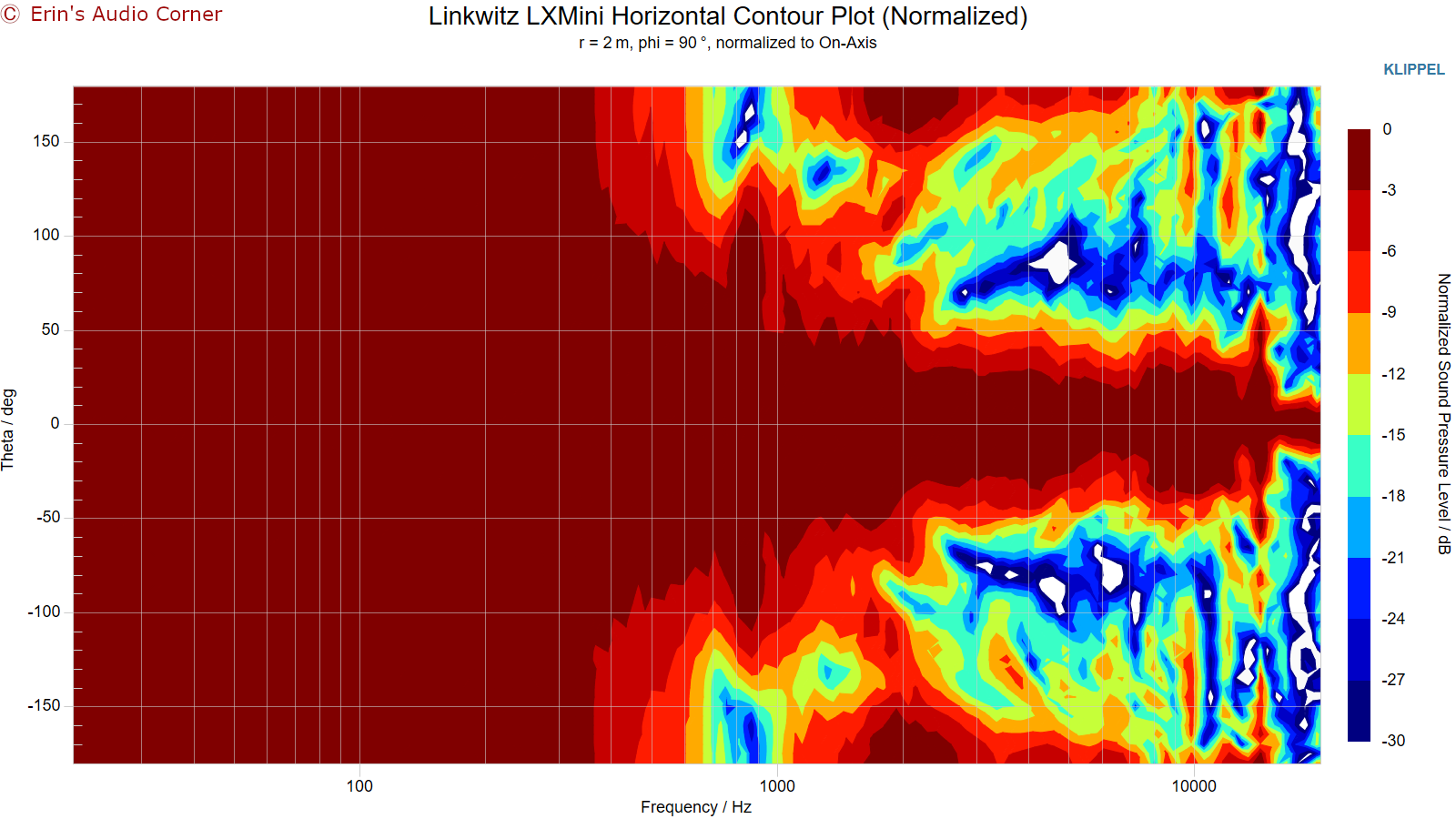
Vertical Contour Plot (normalized):
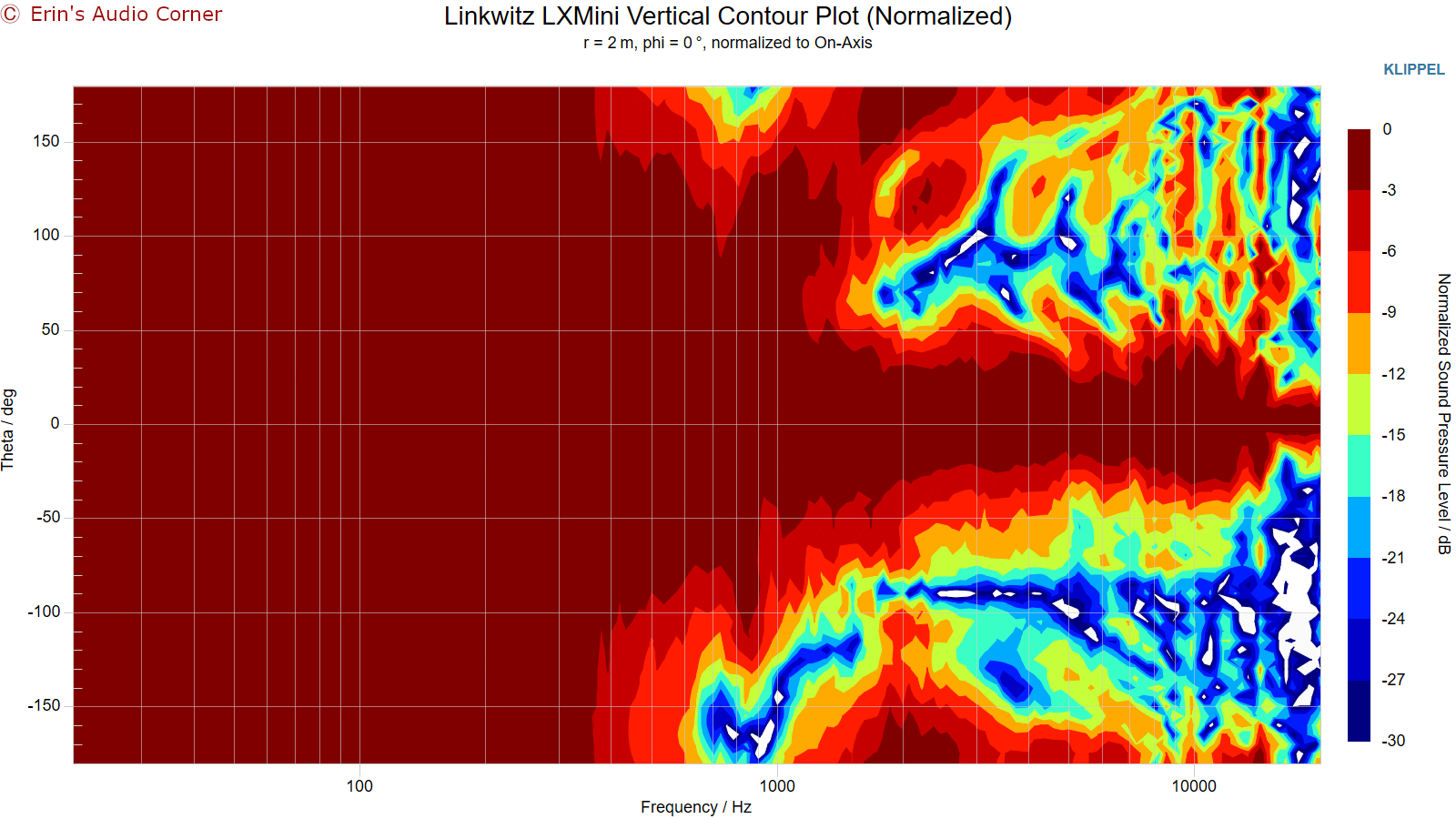
“Globe” Plots
Horizontal Polar (Globe) Plot:
This represents the sound field at 2 meters - above 200Hz - per the legend in the upper left.

Vertical Polar (Globe) Plot:
This represents the sound field at 2 meters - above 200Hz - per the legend in the upper left.
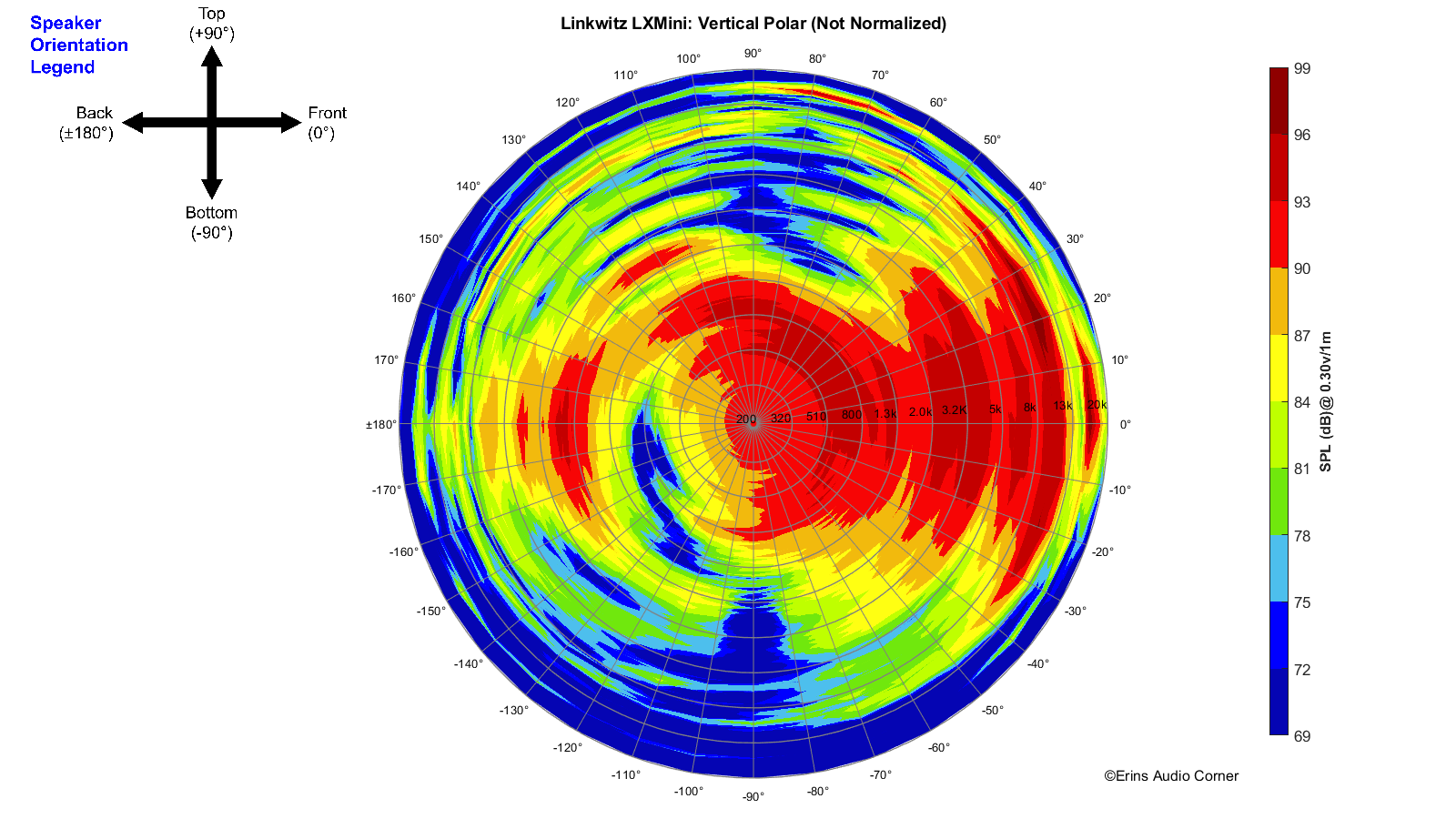
Additional Measurements
Response Linearity
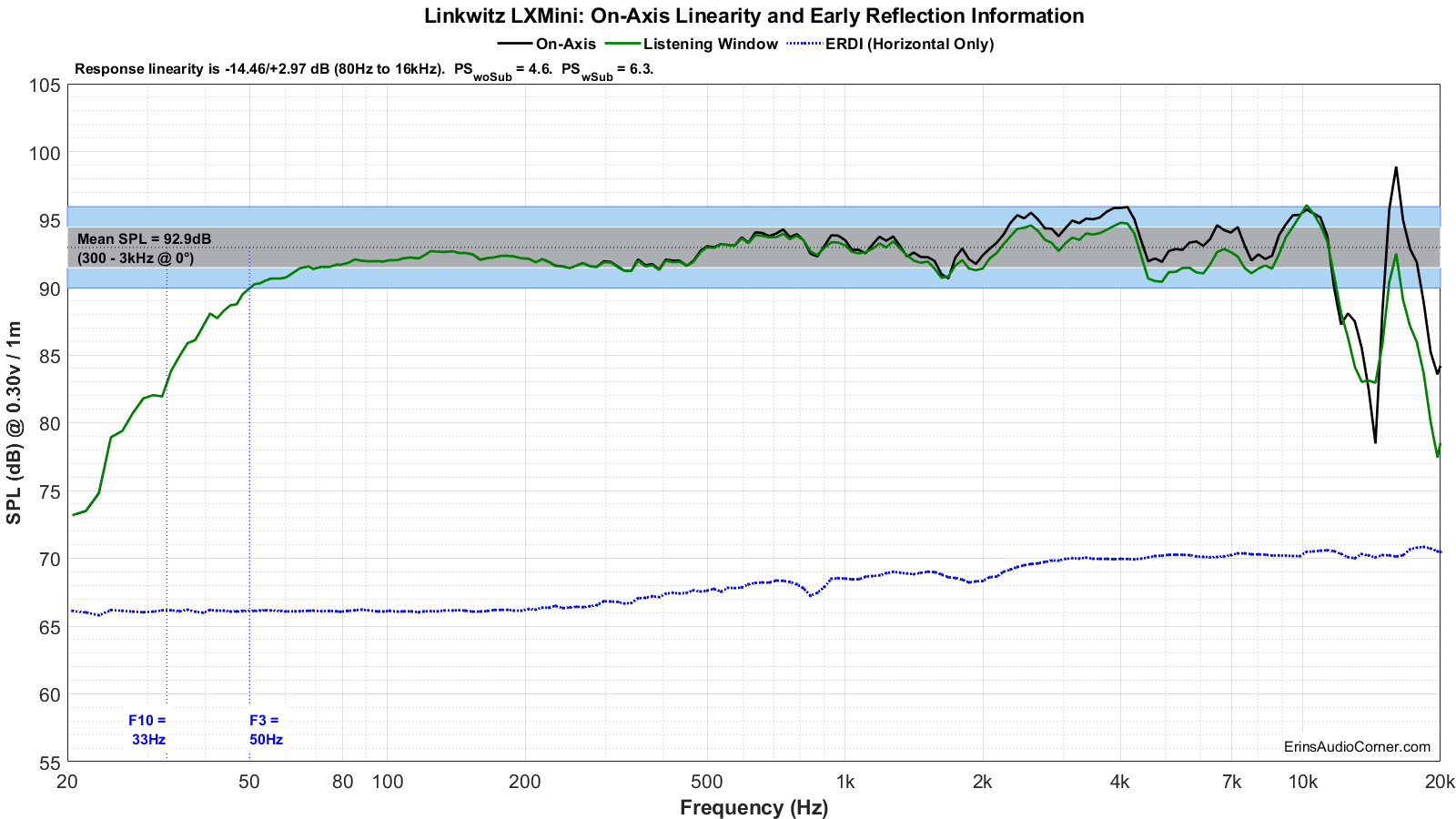
Step Response
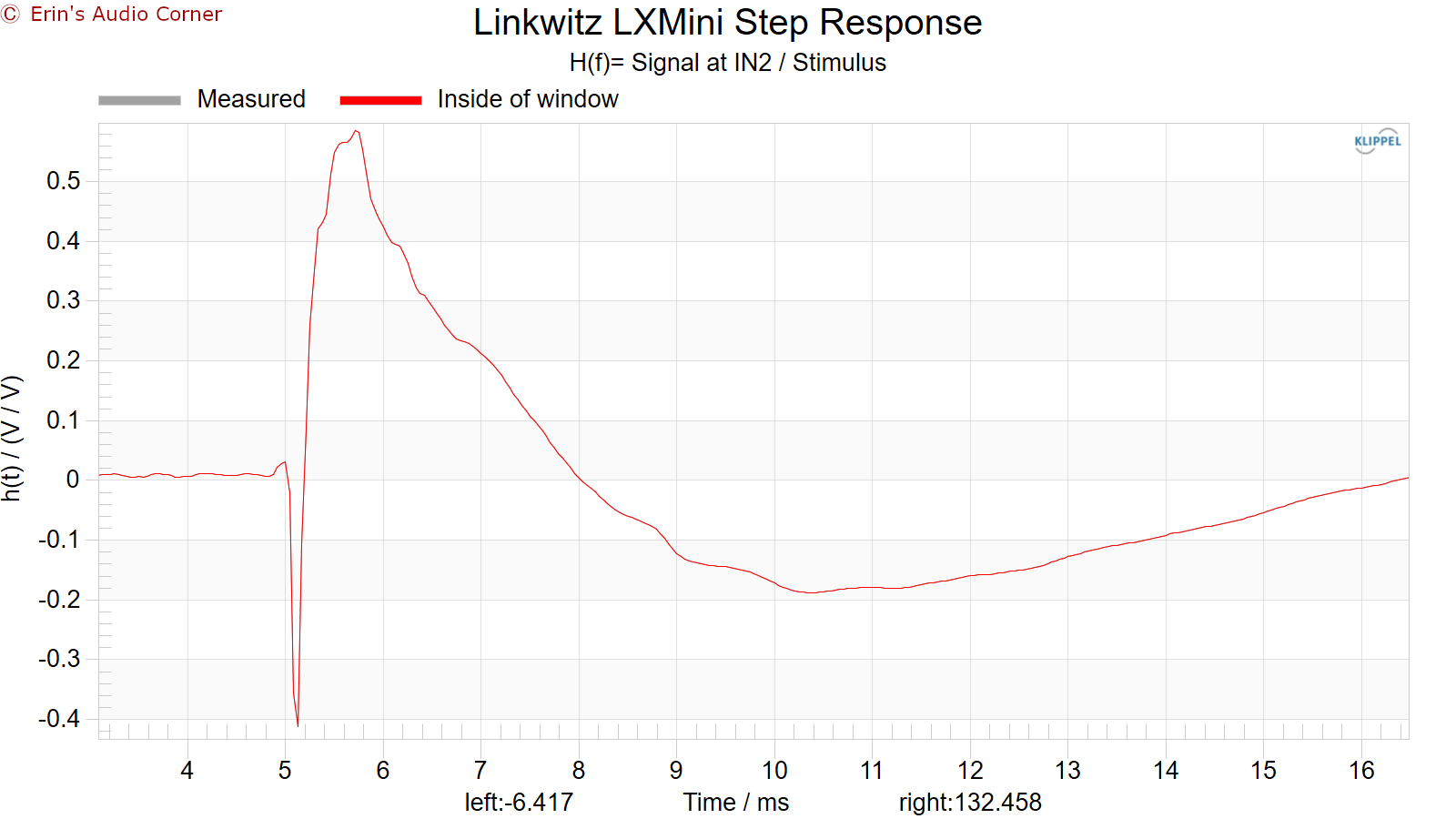
Group Delay
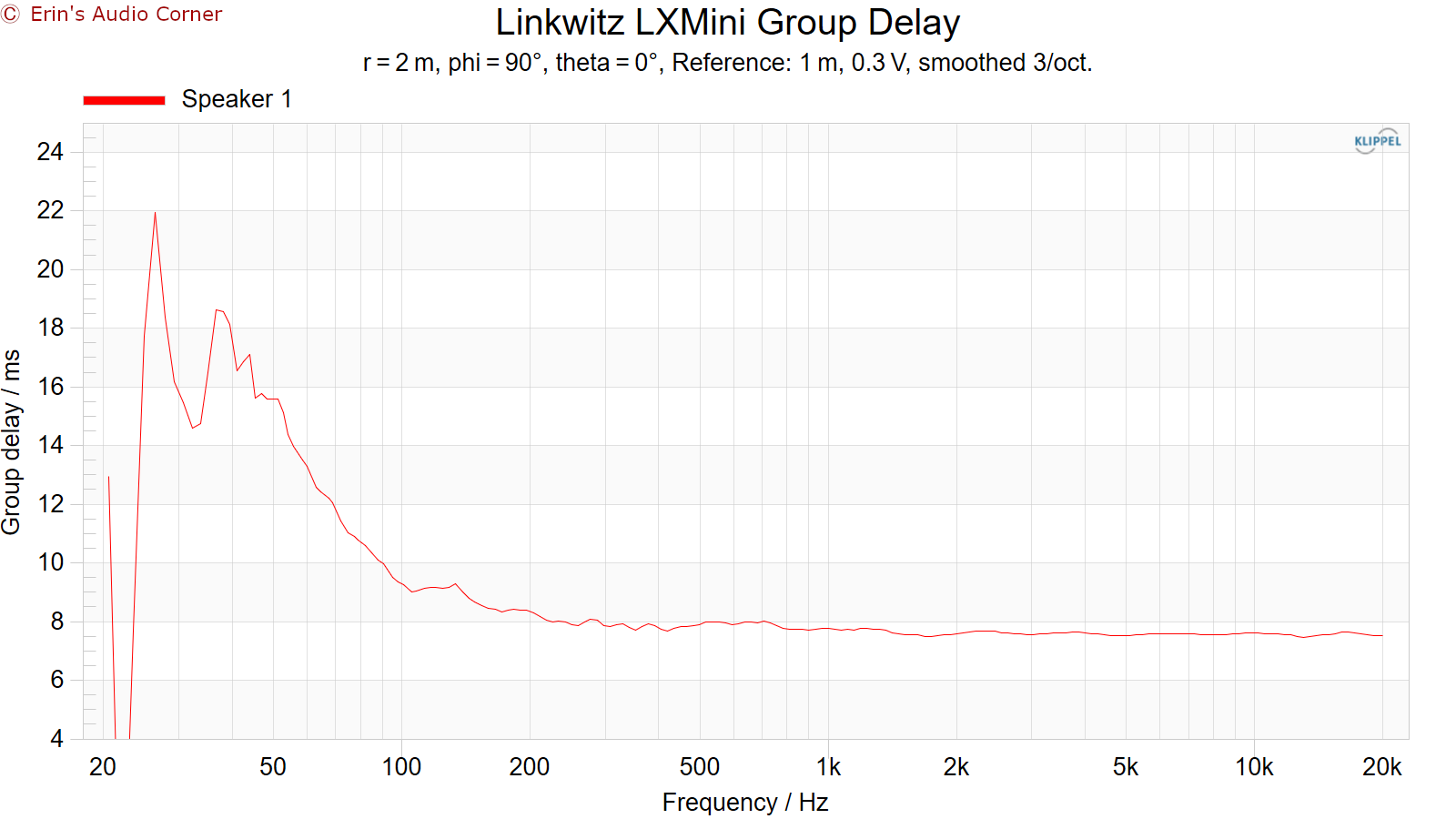
Harmonic Distortion
Harmonic Distortion at 86dB @ 1m:
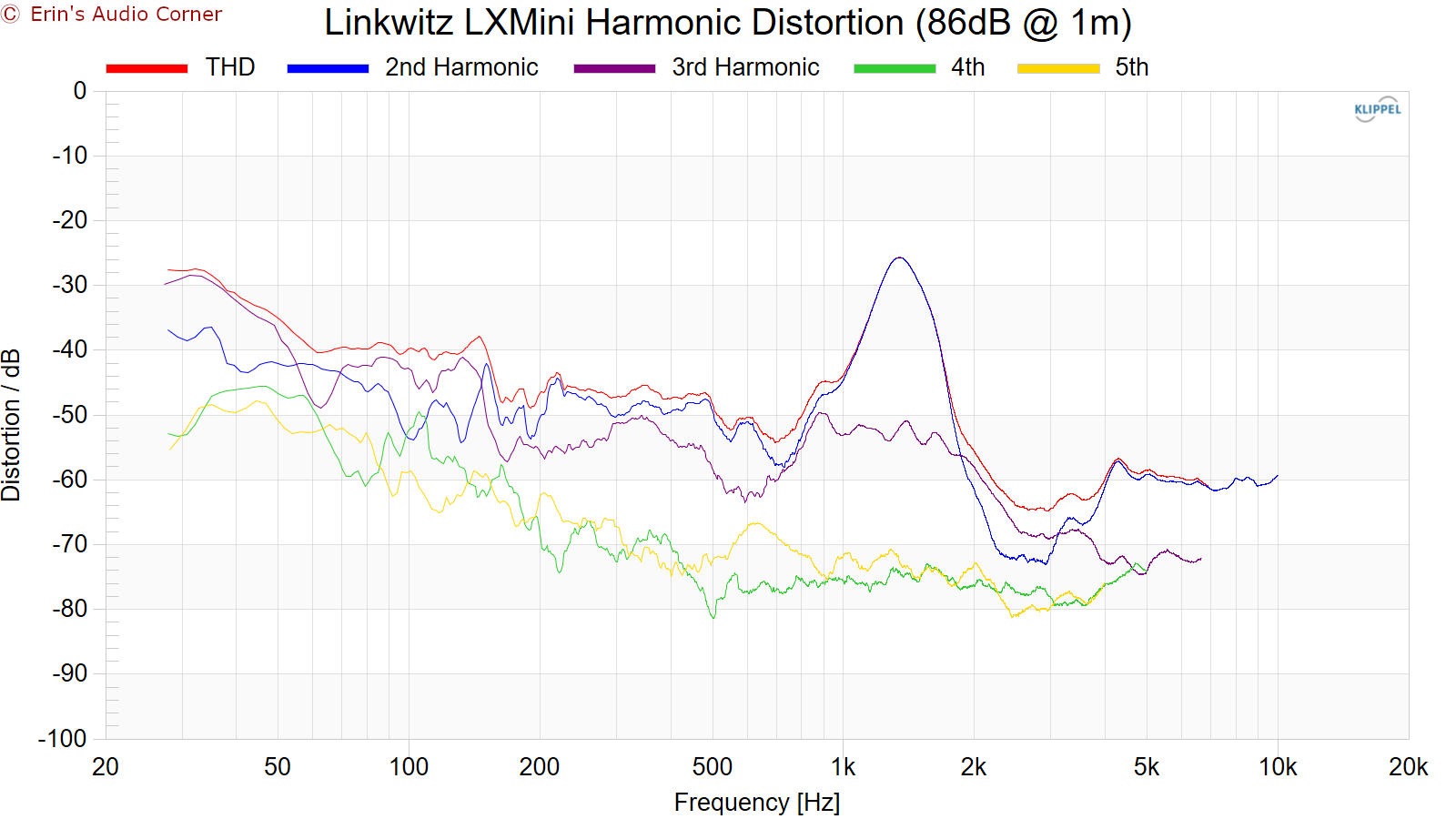
Harmonic Distortion at 96dB @ 1m:

Dynamic Range (Instantaneous Compression Test)
The below graphic indicates just how much SPL is lost (compression) or gained (enhancement; usually due to distortion) when the speaker is played at higher output volumes instantly via a 2.7 second logarithmic sine sweep referenced to 76dB at 1 meter. The signals are played consecutively without any additional stimulus applied. Then normalized against the 76dB result.
The tests are conducted in this fashion:
- 76dB at 1 meter (baseline; black)
- 86dB at 1 meter (red)
- 96dB at 1 meter (blue)
- 102dB at 1 meter (purple)
The purpose of this test is to illustrate how much (if at all) the output changes as a speaker’s components temperature increases (i.e., voice coils, crossover components) instantaneously.
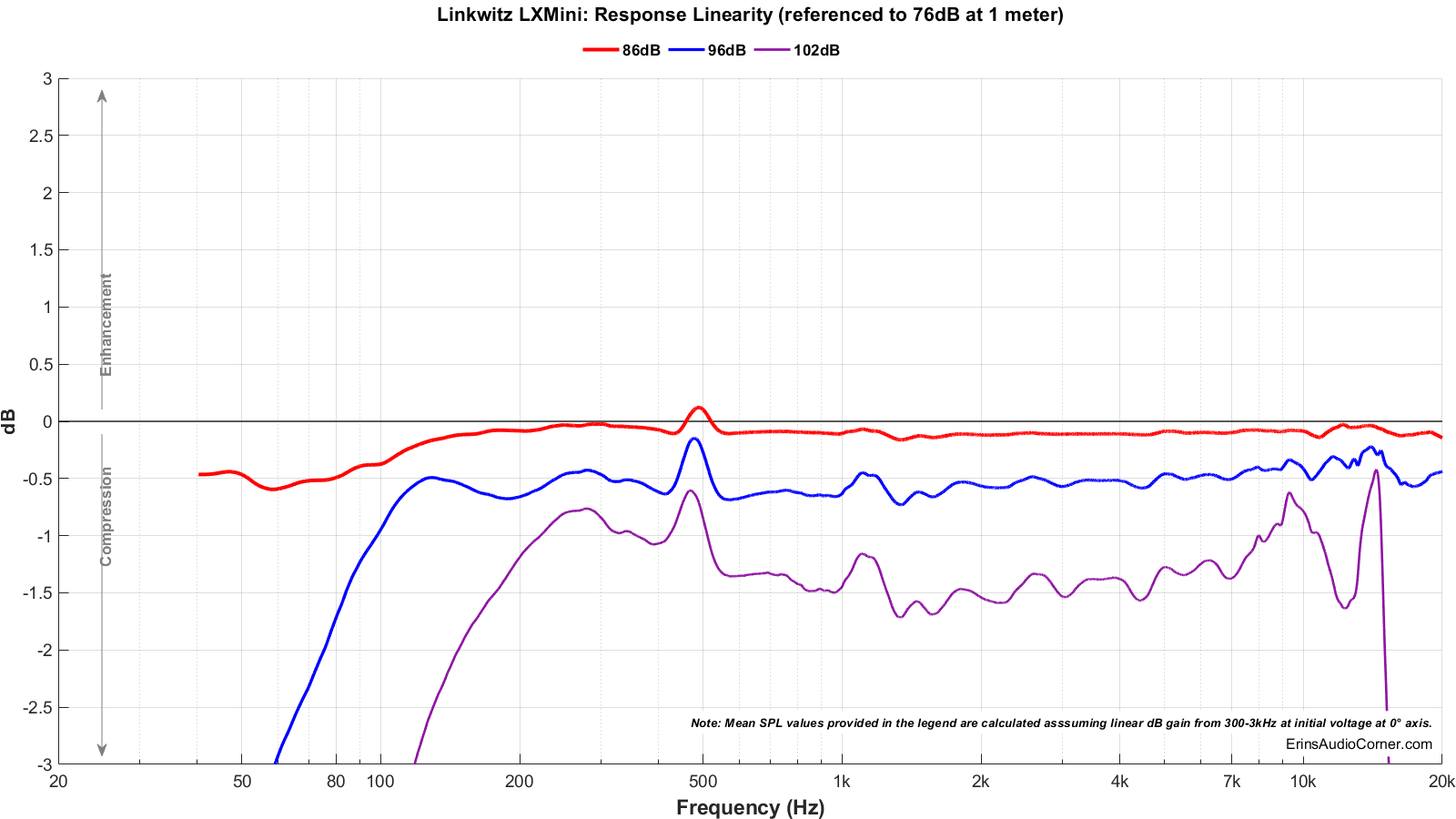
Multitone Distortion
The following tests are conducted at (4) approximate equivalent output volumes: 70/79/87/96dB @ 1 meter. The (4) voltages listed in the legend result in these SPL values.
The test was conducted in (3) manners:
- Full bandwidth (20Hz to 20kHz)
- 80Hz to 20kHz
The reason for the two measurements is to simulate running the speaker full range vs using a high-pass filter at 80Hz. However, note: the 2nd test low frequency limit at 80Hz is a “brick wall” and doesn’t quite emulate a standard filter of 12 or 24dB/octave. But… it’s close enough.
For information on how to read the below data, watch this video:
- Full bandwidth (20Hz to 20kHz)

- 80Hz to 20kHz
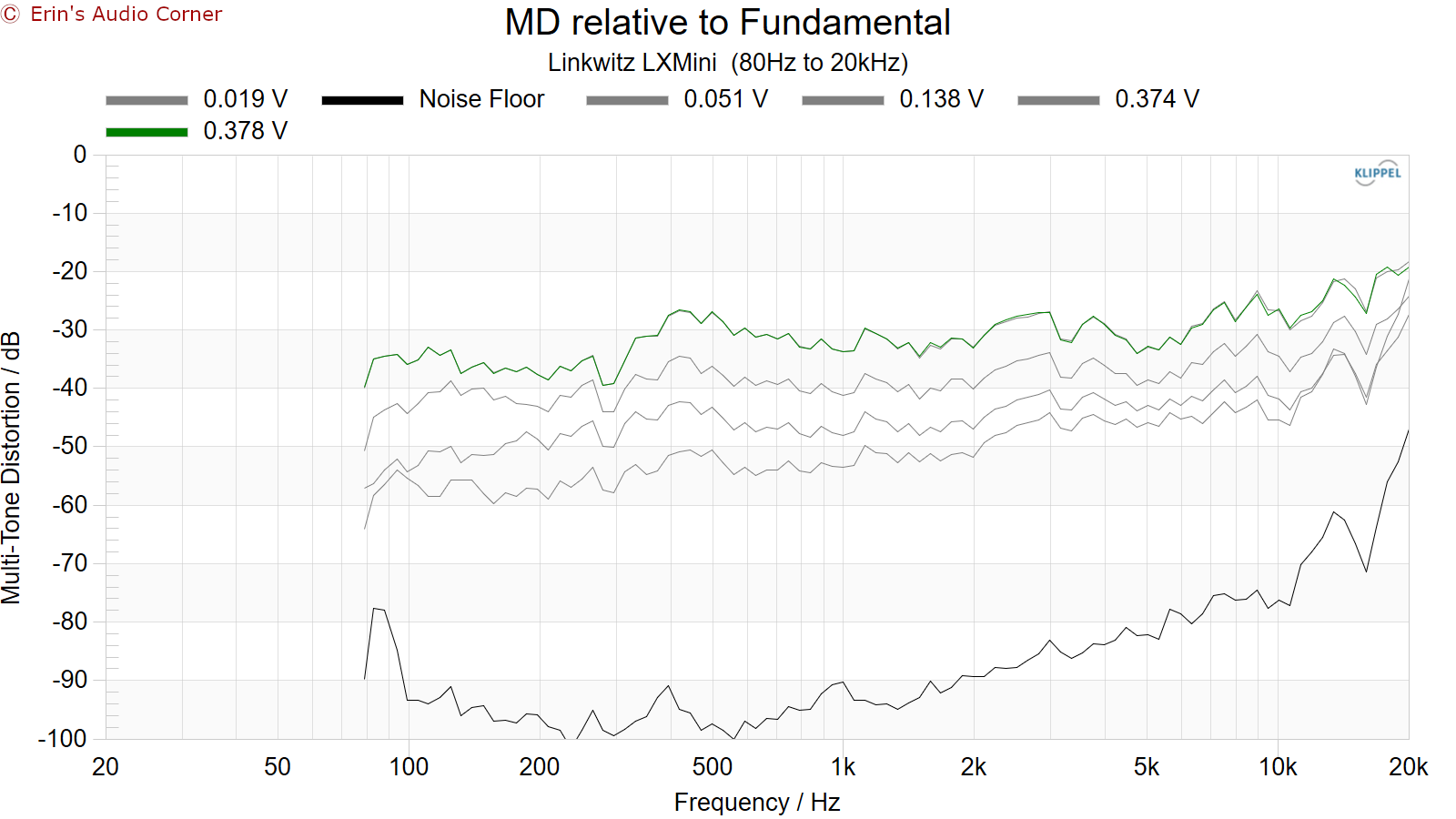
Updated MiniDSP EQ Settings
After evaluating the speaker and comparing the listening notes to that of the data, I decided to attempt to tweak a few things that might help my overall subjective opinion. The MiniDSP settings had a few blank slots for each of the drivers so I loaded the on-axis data into REW and played around with a few EQ adjustments. I landed on (4) new bands in the fullrange and adjusting (2) existing bands. I also added a low-shelf filter on the woofer at about 550Hz to better align the LF to MF in this region. While I wound up not settling on these in my listening - rather, I fell back to only 3 bands of EQ on the HF - I think it’s still useful to show just how readily the response can be tweaked (and how the DI curves do not change, as expected).
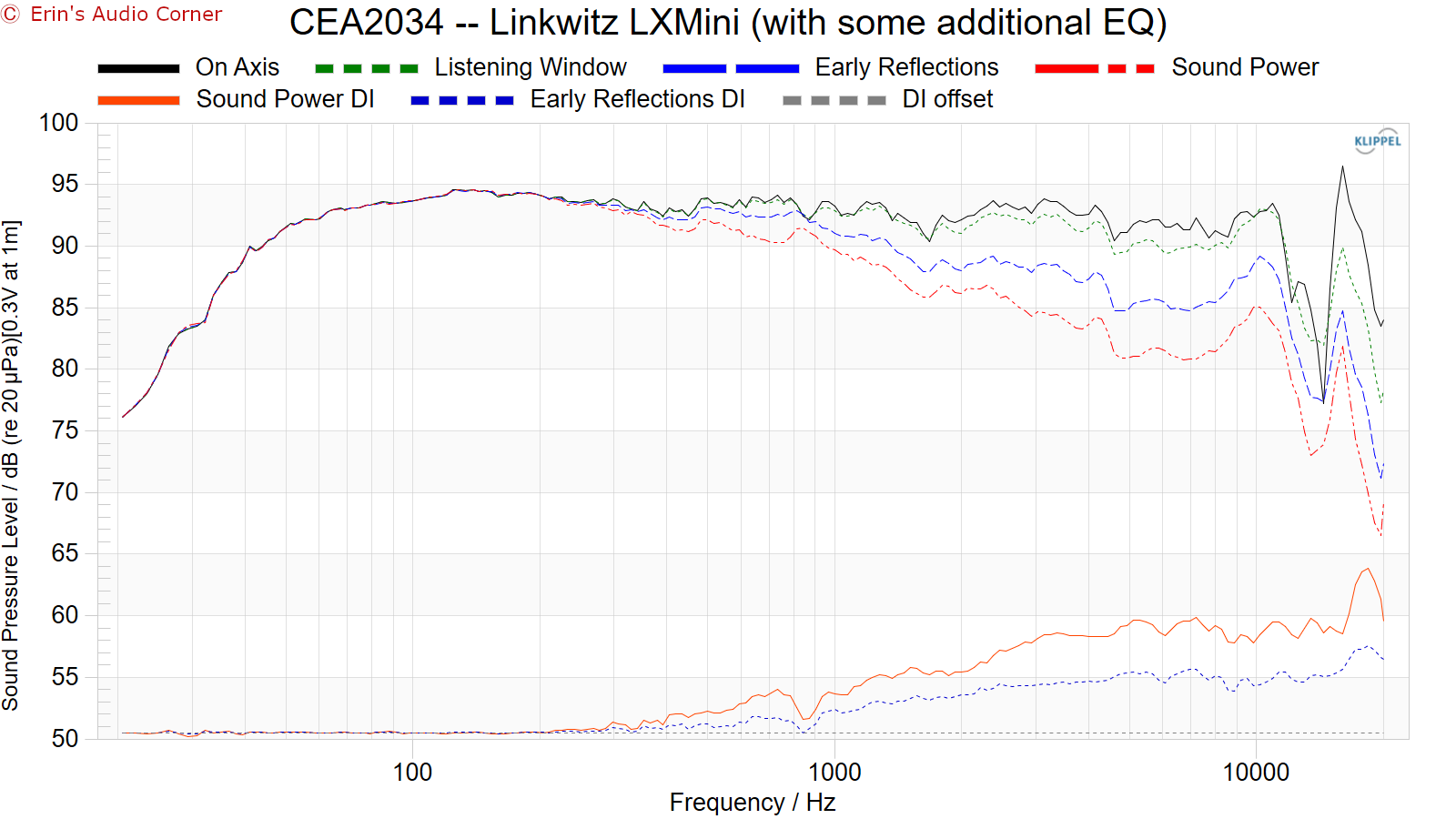
Parting / Random Thoughts
As stated in the Foreword, this written review is purposely a cliff’s notes version. For details about the performance (objectively and subjectively) please watch the YouTube video. But a couple quick notes based on my listening and what I see in the data:
- In my opinion, this speaker shines in the soundstage category. In some ways, it reminded me of my experience with the Bose 901 Series V in that both speakers presented a soundstage that exceeds what standard “box” speakers tend to present. The soundstage of these speakers was not “confined” or “boxed in” like most speakers I hear. Rather, it was more “open” and the boundaries didn’t have an exact cutoff; they just extended into the space of the room. Something I really dig. I should clarify this is only a mild similarity with the Bose 901; the LXMini is far better in both imaging precision and tonality.
- The “default” tonality via the MiniDSP settings wasn’t to my liking so I adjusted a few bands of EQ and quickly shaped the tonality to provide what sounded good to me. That’s the beauty of this kit; it takes reasonably well to EQ thanks to the relatively smooth DI and you already have the EQ available… might as well take advantage of it to shape the response to what you want.
- The HD results are perplexing. There is a quickly rising 2nd-order distortion around 1.5kHz which comes from the 4-inch driver (isolating this driver only yielded the same result). I tried a number of things to see if I could find a root cause; checking for loose parts, sealing the midrange enclosure (just to check), disassembling and reassembling the fullrange/woofer connection assembly… even adjusting the amplifier gains and testing at lower levels. I tested both units and the results were the same. No matter what I did, this peak remained. An impedance sweep shows a mild resonance here and I’m left at this point to conclude either there must be some sort of disturbance between the driver’s backside and the exposed portion of the tube or the driver itself has a resonance here. Given how much of a pain it is to attach the midrange to the tube I didn’t feel like re-doing that process so I called it quits on that investigation and the results will simply be what they are without a root-cause for the time being. It is worth noting this doesn’t show up in my multitone testing nor are there signs of obvious resonance in the CEA-2034 data.
- This speaker is output-limited in its default configuration. I’m frankly not sure how much of this is due to the MiniDSP vs the mechanical limits of the speaker. The DSP does have a compression option but it is disabled in the default LXMini configuration. The maximum voltage I fed it to get to 102dB @ 1m was ~0.70VRMS which is just within the limits of the MiniDSP. I imagine some alterations to the DSP settings would allow one to eke out additional output but I didn’t go down that rabbit hole. Yet.
Overall, really fun speaker. Not perfect tonality but what it does in the soundstage is enough to keep me pushing ahead with further EQ options which this speaker will take well to given its good directivity index. If you are interested I definitely recommend giving it a shot. And take the time to go through Madisound since they were so cool in helping me out with getting these speakers for review.
Support / Contribute
If you find this review helpful and want to help support the cause that would be AWESOME! There are a few ways you can do so below. Your support helps me pay for new items to test, hardware, miscellaneous items needed for testing, new speakers to review and costs of the site’s server space and bandwidth. Any help is very much appreciated.
Join my Patreon: Become a Patron!
If you find yourself interested in buying this speaker, please consider using one of my affiliate links below. It costs you no additional money but does help me earn a small commission which helps me pay for gear to test and other review gear.
You can also join my Facebook and YouTube pages if you’d like to follow along with updates.